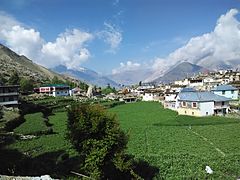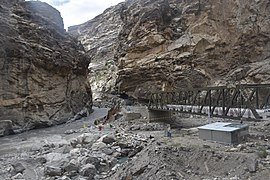31°35′N 78°25′E Kinnaur district is one of the twelve administrative districts of the state of Himachal Pradesh in northern India.[1] The district is divided into three administrative areas (Kalpa, Nichar (Bhabanagar), and Pooh) and has six tehsils. The administrative headquarters of the district is at Reckong Peo. The revered Kinnaur Kailash mountain, one of the Panch Kailash sites, is situated in Kinnaur. As of 2011, it is the second least populous district of Himachal Pradesh (out of 12 districts), after Lahaul and Spiti.[2]
Kinnaur district | |
|---|---|
Clockwise from top-left: Kamru Fort, Chandika Devi Temple, Reckong Peo, Nako Lake, Kinnaur Kailash, view of Kalpa | |
 Location in Himachal Pradesh | |
| Country | |
| State | |
| Headquarters | Reckong Peo |
| Tehsils | Kalpa, Pooh, Sangla, Moorang, Hangrang, Bhaba Nagar. |
| Area | |
• Total | 6,401 km2 (2,471 sq mi) |
| Population (2011) | |
• Total | 84,121 |
| • Density | 13/km2 (34/sq mi) |
| • Urban | 0.00% |
| Demographics | |
| • Literacy | 88.37%(male), 71.34%(female) |
| • Sex ratio | 819[3] |
| Time zone | UTC+05:30 (IST) |
| Vehicle registration | HP-25, HP-26, HP-27 |
| Major highways | National Highway 5 (India) |
| Website | hpkinnaur |
Around 235 km (146 mi) from the state capital, Shimla, Kinnaur is located in the northeast corner of Himachal Pradesh, bordering Tibet to the east. It has three high mountain ranges, namely Zanskar and the Himalayas, that enclose the valleys of Baspa, Satluj, Bhaba and Spiti, as well as their tributaries. The slopes are covered with thick wood, orchards, fields and hamlets. At the peak of Kinnaur Kailash mountain is a natural rock Shivling (Shiva lingam). The district was opened to outsiders in 1989. The old Hindustan-Tibet Road passes through the Kinnaur valley along the bank of river Sutlej and finally enters Tibet at Shipki La pass. Kinnaur is the second richest district in terms of per capita income after Solan in Himachal Pradesh.

History
Kinnaur was a part of erstwhile Chini Tehsil of Mahasu district. It became a separate district on 1 May, 1960.
Earlier Kinnaur was a north-eastern segment of the erstwhile Bushahr principality, which had its capital at Kamru. Later, the capital was shifted to Rampur Bushahr. After the fall of the Kannauj Empire, the rulers of Kamru annexed adjoining territories by force and laid the foundation of the state of Bushahr. Kinnaur belonged to it till the dissolution of the state after independence of India. In the absence of authentic historical records the early history of the Kinnaur region is obscure and the reference of the Kinnaur or Kannaura and their land is by and large confined to legends and mythological accounts.[4]
Kinnaur also has historical cultural links with Ngari Prefecture of the Tibetan Autonomous Region.[5]
Geography

With a mountainous area, ranging in altitude from 2,320 to 6,816 metres (7,612 to 22,362 ft), Kinnaur is one of the smallest districts in India by population. It is known for the Kinnaur Kailash, a mountain sacred to Hindus, close to the Chinese border.
Demographics
| Year | Pop. | ±% p.a. |
|---|---|---|
| 1901 | 27,232 | — |
| 1911 | 28,470 | +0.45% |
| 1921 | 28,191 | −0.10% |
| 1931 | 30,445 | +0.77% |
| 1941 | 33,238 | +0.88% |
| 1951 | 34,475 | +0.37% |
| 1961 | 40,980 | +1.74% |
| 1971 | 49,835 | +1.98% |
| 1981 | 59,547 | +1.80% |
| 1991 | 71,270 | +1.81% |
| 2001 | 78,334 | +0.95% |
| 2011 | 84,121 | +0.72% |
| source:[6] | ||
According to the 2011 census, Kinnaur district has a population of 84,121.[7] This gives it a ranking of 620th in India (out of a total of 640). The district has a population density of 13 inhabitants per square kilometre (34/sq mi). Its population growth rate over the decade 2001-2011 was 7.61%. Kinnaur has a sex ratio of 819 females for every 1000 males, and a literacy rate of 80%. The entire population was rural. Scheduled Castes and Scheduled Tribes make up 17.53% and 57.95% of the population respectively.[7]
| Religions in Kinnaur district (2011)[8] | ||||
|---|---|---|---|---|
| Religion | Percent | |||
| Hinduism | 76.95% | |||
| Buddhism | 21.50% | |||
| Christianity | 0.58% | |||
| Islam | 0.53% | |||
| Other or not stated | 0.44% | |||
| Distribution of religions | ||||
Languages
Kannaura people speak about eight language varieties, seven from Sino-Tibetan language family; Kinnauri, Chitkuli, Sumcho, Jangrami, Poo Kinnauri, Sunam,[10] Nesang and one from an Indo-Aryan language family, called Pahari Kinnauri.[11] Also see [12] At the 2011 census, 72% of the population in the district spoke or knew native languages of Kinnaur, 16.65% Hindi and 7.03% Nepali as their first language.[9] Although, Hindi is fast emerging as the language of choice in most domains, especially the young speakers, due to the demands of modernity which has threatened the native languages.[13]
Climate


Most of Kinnaur enjoys a temperate climate due to its high elevation, with long winters from October to May, and short summers from June to September. The lower parts of the Sutlej Valley and the Baspa Valley receive monsoon rains. The Baspa valley receives highest rainfall in July month.[14] The upper areas of the valleys fall mainly in the rain-shadow area. These areas are considered to be arid regions, similar to the climate of Tibet and Central Asian countries. A study by the IIT Delhi in 2016 established that Kinnaur district has the cleanest air in the country[15]
Flora and fauna
Portions of Kinnaur are situated high in the Himalaya, where vegetation is sparse and consists primarily of hardy grasses. Alpine species such as juniper, pine, fir, cypress, and rhododendron can be found at elevations between 3,500 and 5,000 metres, primarily in Middle Kinnaur. At lower altitudes, temperate-climate trees are found, including oak, chestnut, maple, birch, alder, magnolia, apple, and apricot.
Yaks and dzos are reared by local farmers in the higher areas. Scattered populations of the Himalayan black bear and small ponies may also be found.
Rupi Bhaba Wildlife Sanctuary
Rupi Bhaba Wildlife Sanctuary is spread over an expanse of 503 sq.km. of Rupi Bhaba, Kinnaur. In 1982, a 239 sq. km. portion of the Bushahr state forests was declared the Rupi Bhaba Wildlife Sanctuary.[16]
To the north, it covers main Srikhand Dhar, starting from Kokshane Peak.
To the east, it covers the ridge line from high points 5567 meters, on the main Srikhand mountain range, heading south, diving first Nichar from Murang Tehsil then Kalpa Tehsil till the point on the ridge line of Mukim Dhar up to peak 5496 meters.
To the south, it meanders through Listrang Gad, Khosyan, Angyar Ghat, Wanger Khad, Soling Dhar, Saknatpa PF, Kandarn Khad, Shorang Khad, and Bara Kamba etc.
To the west, starting from the high point 3038 meters, along the boundaries of Shimla and Kinnaur to Srikhand Dhar via Gushu Pishu Peak, up to Kokshane Peak.
The flora includes kharsu, oak, weeping fig, alpine, chir pine, Himalayan temperate forest, coniferous and dry broad leaved coniferous. The fauna of Rupi Bhaba Wildlife Sanctuary includes snow leopard, brown bear, Himalayan tahr, blue sheep, Indian fox, and musk deer.
Politics
| No. | Constituency | Member | Party | Remarks | Reference | |
|---|---|---|---|---|---|---|
| 68 | Kinnaur (ST) | Jagat Singh Negi | Indian National Congress | |||
Transport
Air
No direct flight commute to Kinnaur. The nearest airport is Shimla Airport that is connected with all the major cities.
Rail
Kinnaur does not have any railway service commuting directly to the place. One can reach Shimla that is connected by a narrow-gauge railway line from Kalka.[17]
Road
Connected by National Highway 05 Kinnaur can be easily reached via Shimla. Busses run by Himachal Road Transport Corporation ply from Shimla to different parts of Kinnaur.
Gallery
- Leo, view from NH-505 near Nako
- Confluence of the Spiti (left) with the Satluj (right) near Khab
- Sutlej River in Kinnaur Valley
See also
References
External links
Wikiwand in your browser!
Seamless Wikipedia browsing. On steroids.
Every time you click a link to Wikipedia, Wiktionary or Wikiquote in your browser's search results, it will show the modern Wikiwand interface.
Wikiwand extension is a five stars, simple, with minimum permission required to keep your browsing private, safe and transparent.









